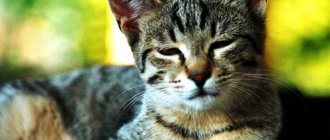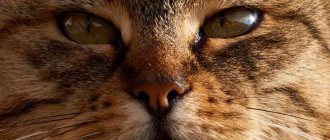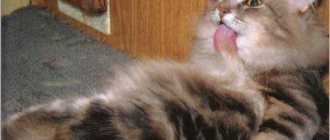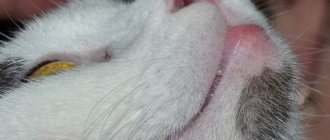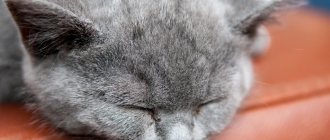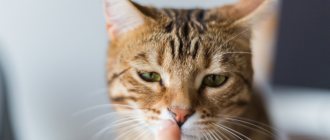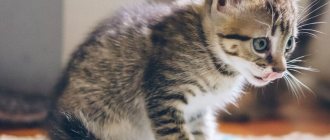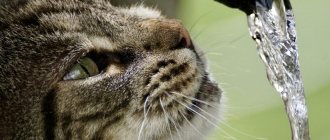A caring owner is concerned about why the cat has become lethargic and sleeps all the time. This condition occurs in kittens and adult cats. There can be many reasons. To find out what it is connected with, you need to contact a veterinarian and conduct a series of diagnostic tests. If you do nothing, serious complications are possible, including death.
Why is the cat acting lethargic?
This state means complete indifference to the environment, weakness, drowsiness, the animal lies all the time, does not react to the outside world, perhaps even refuses to eat. Lethargy in cats occurs for the following reasons:
- middle age;
- taking medications;
- decrease in hemoglobin in the blood;
- heart and vascular diseases;
- inflammatory processes, infections;
- injuries;
- tumors;
- neurological diseases;
- disruption of hormone levels and endocrine system;
- helminths;
- piroplasmosis;
- being in a stuffy room.
Symptomatic treatment and procedures
If the cat has become lethargic, then there is no need to try to play with it, force feed it or pet it. It is important to listen to the animal and take into account its needs.
Perhaps the animal refuses its usual food. You can try offering a different brand of food or food from the table: fermented milk products, boiled meat or fish with porridge. You can offer your animal fresh greens.
If your cat's apathy is associated with stress and depression, you can give her a few drops of valerian or motherwort.
Fresh, cool air often helps relieve lethargy. Especially if it is very hot outside or indoors. The cat becomes lethargic and hides from the heat in a cool place (under the bed, behind a closet). If it’s winter outside, try to ventilate your apartment properly: this is useful not only for animals.
Diseases accompanied by lethargy
Anemia and apathy
A pet's lethargic state can be caused by a low level of hemoglobin, which is caused by poor nutrition.
The cat has become less active, has stopped enjoying life normally, is not eating well, the mucous membranes have become pale - one of the reasons may be anemia. This means that there is a decrease in the number of red blood cells and hemoglobin in the pet’s blood. Factors that contribute to anemia can be both poor diet and various diseases.
Stomach diseases
If the cat does not eat well and sleeps constantly, he experiences periodic vomiting, diarrhea, he has become passive, it is necessary to check the organs of the gastrointestinal tract. The cat becomes weak. Perhaps she will eat inedible objects. When nauseated, swallows fur or balls of hair to induce vomiting.
Diseases of the cardiovascular system
The reasons are completely different. Most often develop after an infectious disease. The cat becomes apathetic, lethargic, eats poorly, plays little, blood pressure is low, and breathing is rapid. The mucous membranes become bluish in color. Swelling appears. There may be an increase in body temperature, the cat is hot to the touch and sad. In severe cases, the weight sharply decreases or increases. The animal trembles, drinks a lot, breathes heavily with its mouth open, hides from people, and does not get up.
Infections and inflammation
Infectious inflammations are accompanied by symptoms such as coughing or vomiting.
Diseases of an infectious and inflammatory nature are manifested by changes in the cat’s behavior. He eats nothing all day, lies inactive, and hardly plays. This passive state is accompanied by other signs. In case of kidney ailments - swelling of the cat's face, paws, rapid breathing, she often goes to the toilet, vomiting and weight loss are possible. Rhinotracheitis occurs similarly to a respiratory infection in humans. Accompanied by nasal congestion, cough, watery eyes, the cat is hot, the mucous membranes of the nose and throat are swollen. The nose is dry and cold.
Piroplasmosis
The carrier is ticks infected with Babesia. Most often they bite unvaccinated cats during the peak of activity, that is, in spring and autumn. Pets develop weakness and become apathetic. The cat eats little and sleeps a lot. A complete refusal of food is possible. A high temperature and pallor of the mucous membranes appear. The urine becomes dark or red. If treatment is not started at an early stage, the animal will die.
Tumor processes
In cats, like in people, education does not make itself felt for a long time. You need to pay attention to your pet’s health in order to recognize it in time. The cat has become lethargic, sad, apathetic, lies constantly, and rarely plays. Usually body weight falls, diarrhea and vomiting occur. With a brain tumor, neurological disorders appear (lethargy, hallucinations, seizures). Sometimes lethargy sets in.
Lethargy in a cat
Does your cat walk around looking lethargic and sad?
It may simply be a decadent mood that will improve on its own. But you should be careful: sometimes the reasons for an animal’s lethargy lie in serious health problems.
A trivial reason may be apathy in the heat, when the air temperature outside the window and in the room is above +30 degrees. The cat could be tired or have a hearty meal. And there are simply phlegmatic cats, which almost always look too calm and sleepy. Often, cats behave very calmly and even sluggishly after estrus, or more precisely, after mating, if the result of a successful mating with a cat is pregnancy. In addition, medications prescribed by a veterinarian (for example, antihistamines or sedatives) can cause some lethargy.
Serious reasons why a cat is lethargic
However, it happens that a cat is lethargic due to illness:
- Stress
. If the cat has become lethargic, it may be due to a mental disorder, which can occur in pets for various reasons, for example, when moving to a new home, changing owners, having a new pet in the house, or suddenly switching to new food. The main signs of stress in cats include lethargy (although in some cases the pet may look very agitated), refusal to eat or literally gorging, constant licking of fur (even to the point of bald spots), bad behavior (the cat marks and shits outside the tray, screams loudly, gnaws flowers, destroys furniture, etc.). As a rule, stress goes away on its own if you regularly communicate and play with the cat, but in some cases it is necessary to take sedatives; - Poisoning.
If the cat has become lethargic, trembles, breathes loudly and heavily, refuses to eat, has vomiting and/or diarrhea, saliva runs heavily, the mucous membranes have turned red or blue, the temperature has risen or dropped (normal temperature in adult cats is from 37.5 up to 39 degrees, for kittens - from 39 to 39.5 degrees), there is a suspicion that the animal has been seriously poisoned by something. What can cause poisoning in pets? Anything: rotten fish, houseplant juice, washing powder, rodent poison and much more; - Jumps in blood pressure
(very difficult to diagnose!). There is a possibility that the cat is lethargic all the time if she has low or high blood pressure, which normally ranges from 105/65 to 135/95 mmHg. Signs of high blood pressure include apathy, red eyes, dilated pupils, blurred vision (this can be calculated by observing an animal that will bump into walls or furniture when walking), noises during breathing, swelling of the extremities, vomiting, nosebleeds, high pulse (more than 180 beats per minute). Low blood pressure can be recognized by constant drowsiness, loss of appetite due to nausea, decreased heart rate (below 80 beats per minute), and loss of consciousness. If your pet has such symptoms, you need to quickly go to the veterinarian; - Endocrine disorders.
In some situations, a cat is lethargic due to diabetes mellitus or Cushing's syndrome. Plus, don’t forget about hormonal imbalance, which often occurs in pets after giving birth, and even after sterilization, a lethargic cat is common. You can figure out from the following symptoms that your pet has endocrine problems: extreme thirst, frequent urination, changes in appetite (the cat either begins to eat very little or constantly asks to be fed), deterioration in the condition of the coat and skin, an increase in the volume of the abdomen, weight fluctuations, cramps, heaviness of gait, blurred vision, low motor activity as a result of weakening muscles; - Diseases of the musculoskeletal system
, for example, osteochondrosis, arthritis, joint dysplasia, bone fractures, joint dislocations, ligament rupture. Find out that a cat has problems of this nature simply by the following symptoms: lameness, refusal to jump, change in gait, pain (the cat growls and bites if the owner touches the sore spot), swelling in the area of the affected joints, refusal to eat and apathy. Cats with diseases of the locomotor system often do not sharpen their claws, take poor care of their coats, and do not wash themselves; - Oncology.
If the cat is lethargic, lies down most of the day, eats very little or refuses food at all, is rapidly losing weight and meows pitifully, suffers from vomiting, diarrhea and internal bleeding, the development of cancer can be suspected. Other signs of cancer in cats include bad breath, the appearance of ulcers and minor swelling on the body (in some cases the tumor is visible to the naked eye), aimless wandering around the apartment; - Infectious diseases.
A cat is usually very lethargic with the following infectious diseases: calcivirosis, rhinotracheitis, leptospirosis, panleukopenia, immunodeficiency virus. Common signs of these illnesses include a rise in body temperature, refusal to eat, shortness of breath, cough, wheezing during breathing, vomiting and diarrhea (usually foul-smelling and greenish), changes in the color of mucous membranes, discharge from the nose and eyes; - Parasites internal and external.
We are talking about the most common uninvited guests - worms, ticks and fleas. Helminthic infestations are recognized by stool disorders (a cat may have diarrhea alternating with constipation), vomiting, weight loss, an increase in abdominal volume, flatulence and rumbling in the abdomen, bad breath, greenish discharge from the eyes. Ear mites can be identified by constant shaking of the head, the appearance of a large amount of dark sticky wax, and itching (the animal constantly scratches its ears). Ticks on the body provoke the appearance of wounds and scales on the skin, hair loss to the point of baldness, and constant itching. Other parasites, fleas, manifest themselves in much the same way. Many owners fight worms with deworming agents, and use insectoacaricides to eliminate skin parasites, but before using such products it is better to consult a specialist; - Inflammatory diseases of internal organs.
Almost any inflammation is guaranteed to cause apathy in the cat and a refusal to play. So, a cat can be sad, for example, with gastritis or colitis, pancreatitis, cholecystitis, pyelonephritis, stomatitis, myocarditis. There are plenty of inflammatory diseases, so it’s difficult to name general symptoms. With inflammatory diseases of the gastrointestinal tract in animals, stool disorders and vomiting, bloating, flatulence, blood in the stool, and fever are observed. If there are problems with the urinary system, the cat is lethargic and does not eat for several days or eats but little, there will probably be thirst and pain during urination. If the heart is affected, the pulse will rise above normal and shortness of breath will appear. And if the cat’s mouth is inflamed, the cat will salivate heavily, the gums will become red and swollen, and the appetite will decrease or disappear; - Hypovitaminosis.
Lethargy can also be caused by a lack of vitamins, for example, with a poor, monotonous diet. Animals with this problem are often inferior in height to their counterparts, they have dull hair and poor skin condition (dermatitis, dandruff), females often have miscarriages, and have problems with bowel movements; - Anemia.
If the production of hemoglobin and red blood cells is disrupted, almost all purrs experience weakness, cyanosis of the mucous membranes, shortness of breath, a drop in blood pressure, pulse fluctuations, and deterioration in the quality of the coat; - Dehydration.
With a lack of water in the body, the cat is lethargic and the nose is dry, the skin loses elasticity, the eyeballs look sunken, the mucous membranes dry out, saliva becomes sticky and viscous, and the pads of the fingers are cold to the touch. A cat in this state does not eat and hardly drinks, although it desperately needs water. If the animal cannot be given water even by force, you should immediately contact the clinic, where the doctor will prescribe an infusion of electrolyte solutions subcutaneously or intravenously; - Foreign body in the pharynx or elsewhere in the gastrointestinal tract.
If the cat is lethargic and does not drink, and also refuses to eat, it often vomits and salivates profusely, its voice becomes hoarse, there is a possibility that something is stuck in the throat or elsewhere in the gastrointestinal tract, for example, a fish bone or small part from a toy; - Various complications after surgery
(suppuration or suture dehiscence, postoperative hernia, etc.). If the cat appears lethargic after surgery during the first 1-3 days, then there is nothing to worry about, provided that the animal drinks water and shows at least minimal interest in food. Fever, plaintive meowing, blood or pus from a postoperative wound, constipation, vomiting are reasons to immediately contact the clinic.
What to do if the cat is lethargic all the time?
The only correct solution is to immediately consult a doctor. Making a diagnosis at home or prescribing treatment for your pet on your own is simply unacceptable.
Other reasons
Helminthiasis
If parasites enter a cat's body, it may experience health problems such as diarrhea or hair loss.
The disease is caused by parasites - worms. They can be present in grass, food, soil, water. Once in the animal's body, they use it for survival. The cat has health problems. Symptoms depend on the degree of worm infestation. The cat does not eat, vomiting, diarrhea, cough, hair loss, rashes appear, the pet scratches its butt near the anus. The tummy gets bigger. Symptoms of intoxication appear.
Age of the cat
An old cat becomes lethargic, sleeps a lot, plays little, appetite, hearing, vision and smell are impaired. The fur becomes dull. As an animal ages, its behavior changes. Or the pet becomes more affectionate, climbs into your arms, caresses. Or, on the contrary, he shows nervousness and aggression. The immunity of cats decreases, which is why they are susceptible to infections.
Vaccinations for babies
Vaccination protects animals well from various diseases. However, complications may occur. Both allergies and individual reactions. After vaccination, the kitten eats poorly, is lethargic, drowsy, refuses to eat, and the temperature rises. The nose becomes hot or cold. If these symptoms last more than 3 days or are too severe. you need to contact your veterinarian.
Main reasons
Luckily, many of the main reasons why cats don't eat enough are not serious.
Even though we may think cats are dramatic, they clearly think there are good enough reasons not to eat.
© shutterstock
Food
The obvious reason why your cat may not be eating but is acting normally is most likely due to the type of food she is eating!
As cats age, their senses begin to dull and they may become uninterested in their usual food. This can happen even if your cat has always eaten its own food in the past.
Cats may also simply not want to eat this food for no reason, because that's what cats do! A similar reason is that you may have changed the food your cat is used to. Perhaps you wanted to buy a cheaper or healthier food, or even a new one that was suitable for your stocky cat.
Either way, cats are very finicky creatures, and any change they don't agree with may cause them to simply not eat and wait for you to give them their regular food.
Travel or relocation
Cats like to stay in their territory, so moving to a new place or traveling can have a negative impact on them.
Not only may they hate their new surroundings, but they may also experience motion sickness during a trip or flight, which can cause nausea and loss of appetite.
This cause will likely go away on its own once your cat returns home or gets used to its new home or location.
Stress or psychological problem
Just like people, cats can experience stress and anxiety for a variety of reasons.
Sometimes a change in routine or the addition of a new animal or person can make a cat feel anxious.
Depression is another reason your cat may not eat. Cats that are overly stressed over a period of time become depressed. You may not be around very often, so your cat is bored and sad, which can also cause a lack of appetite.
Cats can also react to the emotional state of their people. If you are nervous and your tone of voice changes, your cat will usually respond to you. They often hide and stay away, but constant exposure to stress can cause overwhelming stress and loss of appetite in your cat.
Recent vaccinations
If your cat's loss of appetite began shortly after your last visit to the vet for vaccinations, these vaccinations are most likely causing the change.
Cats may react negatively to some vaccines, which may cause them to not eat. This problem usually resolves on its own after the side effects go away.
Disease
Disease is something that all cat parents fear when their cat loses its appetite. And, unfortunately, sometimes this is true.
Some conditions, such as infections, intestinal parasites, kidney failure and dangerous cancers, can be the main reasons why your cat stops eating.
© shutterstock
Dental problems
Cats need regular dental care, and it is actually recommended that you brush your cat's teeth at least a couple of times a week to prevent dental diseases such as gingivitis, which is inflammation of the gums around the teeth.
Another serious dental problem is periodontitis, which occurs if your cat's gingivitis is not treated with cleaning.
Gingivitis is moderately painful, and periodontitis can be extremely painful, so if your cat has one of these problems, they will likely not want to eat because it is too painful, especially if their main food source is dry solid food.
Diagnostics
At the appointment, the veterinarian collects an anamnesis from the owner, what the animal did and ate, and then carries out diagnostic procedures.
There are methods that will allow you to make a correct diagnosis and find out why your beloved animals are sick:
- It is necessary to find out what the owner associates the disease with. What did the cat eat, where was it, did it walk outside, what medications did it take. That is, collect anamnesis.
- The doctor takes tests - general blood and urine, biochemistry, feces for coprogram and worm eggs.
- Depending on the symptoms, additional examinations are prescribed - ultrasound, x-rays, surgical diagnostic intervention.
If a cat sleeps all the time, is this normal or pathological?
Long-term sleep is inherent in cat genes and is the result of evolution - domestic cats do not need to hunt in order to get food, as well as to conquer territory. An adult animal can sleep up to 20 hours a day, that is, the time between meals. This occurs in situations where the cat is alone at home all day or no one pays attention to it. The first answer to the question of why cats sleep a lot is boredom - caressed and fed pets have nothing else to do.
Cats do not always sleep soundly; most of the time they are in a state of drowsiness, which is characterized by a completely relaxed posture and closed eyes, but at the same time a readiness to wake up at any moment. This is indicated by:
- twitching ears;
- purring;
- reaction to the slightest noise;
- periodic stretching and other body movements.
A cat's deep sleep is characterized by tightly closed eyes, a curled up body, a tail on its face, and even light snoring. The twitching of a cat's whiskers and paws in a dream indicates that he is having dreams - all pets have the ability to see them.
Caring owners are well aware of all the habits of their pets, including the duration and characteristics of their sleep. Any change in habits can be pathological.
How to treat a pet?
To cure a disease, the cause must be eliminated.
If it is caused by taking medications, stop taking it. For helminthiases, the cat is given a drug that removes them. They go to the toilet and the worms will come out along with the feces. Piroplasmosis is treated with special substances that kill Babesia. In case of inflammation and infections, you need to relieve this process with anti-inflammatory or antibiotics. Maintenance therapy and pills to boost immunity are used. Only a doctor can identify the cause and prescribe the correct treatment.
Why do kittens sleep for a long time?
Any cat owner will confirm that these animals are real sleepyheads, capable of dozing for hours in their favorite place, regardless of the time of day.
On average, these pets sleep 17-19 hours.
And such sleep is beneficial for their body:
- promotes the digestion of protein foods;
- ensures good health;
- maintains the supply of energy necessary for the period of wakefulness.
Babies' sleep. Young kittens also need a lot of sleep, and until 8 weeks of age they sleep almost all the time, waking up only to eat. This period is associated with:
- active growth of the animal;
- strengthening the immune system;
- formation of the nervous system.
By 4-5 months, some of the kittens reach the size of an adult cat. Veterinarians do not recommend preventing a purring pet from sleeping by waking it up or shaking it. These actions can lead to the development of diseases and even death of the pet. If there are no signs of pathology, then you should not disrupt the kitten’s routine.
8-10 weeks after birth, your little pet will get stronger and stay awake longer.
Cat worm disease
Worms or helminthic diseases are most common among cats. Owners of their pets should clearly understand that helminthic diseases can occur even if your pets have not left your apartment. They can become infected with existing parasitic worms through eggs of various helminth infections brought from the street on the soles of their shoes. Cats during walks, in close contact with the environment, expose themselves to the danger of becoming infected with helminth eggs, which are found in large numbers on various objects. A particularly great danger in this regard is provided by the direct contact of your cat with other homeless, stray animals. Being essentially predators, cats never refuse raw fish or meat offered to them, which in our time of market relations can be infected with helminthic infestation. Some types of worms cause characteristic, pronounced symptoms of helminthic disease. With severe infestation, the cat loses a lot of weight, even with a good appetite. A sick cat vomits (vomiting in cats), sometimes with blood, and gastrointestinal tract disorder (diarrhea) appears (diarrhea in cats). Kittens infected in utero may die from blockage or rupture of the small intestine. In young cats we note anemia and gastrointestinal disorders. Other worms, hiding in the muscles or liver of a cat for a long period of time, do not show themselves in any way. Taking into account the above, cat owners need to carry out preventive deworming with anthelmintic drugs. For more information about worms, see our article - worms in cats.
Cat affected by ectoparasites. Very often, our cats suffer from diseases that are caused by various parasites that live both outside and inside the animal’s body. Ectoparasites—fleas, lice, and ticks—settle on the skin of cats.
Fleas are wingless insects with a body flattened on the sides. Only adult individuals parasitize the body of cats; the larvae live in the environment. Fleas are extremely prolific - each female lays 25 eggs daily, which fall down, accumulating on the litter, in the cracks of wooden floors, on carpets, etc. After hatching from the eggs, the larvae, after going through a series of changes, turn into adults, which, when they meet a cat, settle in her fur and switch to a parasitic lifestyle. They bite him and drink his blood; as a result of severe flea infestation, the cat loses weight. The presence of fleas in an animal can be indicated by the presence of small black crumbs on the cat’s body.
Oncological diseases. Like other types of domestic animals, cats are prone to cancer. Moreover, the majority of neoplasms identified in cats are malignant in nature, so this pathology requires complex treatment in a modern veterinary clinic by an experienced veterinary specialist.
A malignant tumor in a cat occurs as a result of a malfunction of DNA molecules, which are a repository of information and are present in every cell of the cat.
A malignant tumor, as it grows, increases in size and begins to grow into the healthy tissue of the affected organs, causing inhibition of their function.
The clinical picture of cancer in a cat depends on the organ affected by cancer, the stage of the disease and the general condition of the cat. For many years, the neoplasm in a cat cannot be externally manifested in any way. Symptoms of the disease in an animal may be vague and unclear.
In cases of liver cancer, veterinary specialists note general weakness, fatigue, decreased appetite in a cat, a change in the consistency and color of feces, and a sharp decrease in weight. The cat begins to develop jaundice (visible mucous membranes, the cornea of the eyes and the skin acquire a yellowish tint). Disease symptoms characteristic of liver disease in cats appear.
Stomach cancer in cats. During a clinical examination, the veterinarian notes that the cat has general weakness, drowsiness, poor appetite, and a painful abdomen on palpation. Increased body temperature. There is a change in the color and consistency of fecal matter, sometimes we find blood clots in the fecal matter, the cat suddenly loses weight, and anemia develops.
Bowel cancer. During a clinical examination, a veterinarian finds the same clinical signs in a sick cat as for stomach cancer. Unlike stomach cancer, fresh, scarlet blood appears in the stool, a foul odor emanates from the feces, and bloating occurs. A fetid odor is felt from the oral cavity, and rumbling sounds are heard on auscultation of the intestines. Depending on the affected part of the intestine, there may be diarrhea (diarrhea in a cat) or, on the contrary, constipation (constipation in a cat (coprostasis).
For more information about oncological diseases in cats, see our article - oncology in cats.
Infectious diseases
Infectious diseases in cats are caused by a variety of bacteria and viruses, in which the animal’s body experiences loss of body weight (weight loss) due to loss of appetite and disorders of the gastrointestinal tract. The most common infectious diseases of cats include - (infectious rhinotracheitis in cats, chlamydia in cats, mycoplasmosis in cats, bordetellosis in cats, calcivirus infection in cats, panleukopenia in cats, infectious peritonitis in cats).
Internal non-communicable diseases
Almost all diseases accompanied by loss of appetite and even the entry of a foreign object into the stomach can lead to weight loss.
Common internal non-contagious diseases in cats include:
Kidney stones in cats or urolithiasis is a chronic disease of cats in which stones and urinary sand (urolithiasis) form in the urinary tract of animals. Urolithiasis (UCD) is a chronic disease associated with metabolic disorders and accompanied in a cat by the formation and deposition of urinary stones, different in chemical composition, or sand in the renal pelvis, urinary ducts, bladder, urethra and leading to disruption of natural outflow urine.
Symptoms of the disease. If a cat’s kidney stones are small and there is no blockage in the urinary tract, then the cat’s disease occurs without obvious clinical signs, but the results of laboratory tests of urine and blood indicate its occurrence. During such a latent period of the course of urolithiasis, symptoms can be detected in a cat that not only indicate its development, but also allow a veterinarian to determine the location of the urolithiasis. The cat's owners notice a decrease in appetite, drowsiness, and depression. When a stone forms in the renal pelvis, a cat develops symptoms characteristic of pyelitis. Owners sometimes find blood in their cat's urine (hematuria), especially after active movements of the cat. The presence of stones in the cat's bladder is manifested by frequent urge to urinate and restlessness. In the case when a kidney stone begins to move along the ureter and causes its blockage, we observe ureteral obstruction. With partial obstruction of the ureters, owners note difficulty urinating in the cat. Urination becomes strained, and the cat sometimes cries while peeing. The cat's urination becomes frequent with the release of a small amount of urine; upon careful examination, blood can be detected in the urine. Additionally, the owners note a lack of appetite in the cat, vomiting, and the abdominal area becomes painful upon palpation.
For treatment and prevention of this widespread disease in cats, see our article - Kidney stones in cats or urolithiasis.
Liver diseases – Hepatitis is the general name for inflammatory diseases of the liver tissue. Hepatitis often occurs simultaneously with diseases of the stomach, intestines, pancreas and other organs. With hepatitis, the gallbladder and bile ducts are almost always involved in the process. Hepatitis is accompanied by profound disturbances in protein, carbohydrate-fat and pigment metabolism, and liver cells disintegrate.
Cirrhosis of the liver - in a cat, it is accompanied by a change in the liver’s structure due to the growth of connective tissue in the liver.
Liver failure is a severe pathological condition of an animal in which liver function is impaired. Liver failure in cats can occur in acute and chronic forms.
Main symptoms of liver disease in cats.
Liver disease in cats is characterized by a number of signs that should alert its owner. An owner can suspect liver disease in their cat based on the following symptoms:
Vomiting in a cat. Cat has diarrhea. Jaundice, in which icteric staining of the mucous membranes and subcutaneous tissue occurs in a yellow color. Skin itching. Change in urine color, from yellow to brown. Change in color of feces from brown to gray or brown. Abdominal dropsy, ascites - an increase in the volume of the abdomen due to the accumulation of fluid in the abdominal cavity. An increase in the size of the liver, which manifests itself as a protrusion through the abdominal wall. Pain in the liver area (hepatic colic). Multiple hemorrhages in the skin and subcutaneous tissue. Poor blood clotting.
A number of endocrine diseases - problems with the thyroid gland, diabetes (even cats are susceptible to this insidious disease) are certainly accompanied by weight loss even with an increased, and sometimes perverted, appetite.
Diseases of the digestive system lead to a cat’s weight loss, even while maintaining the same amount of food eaten.
